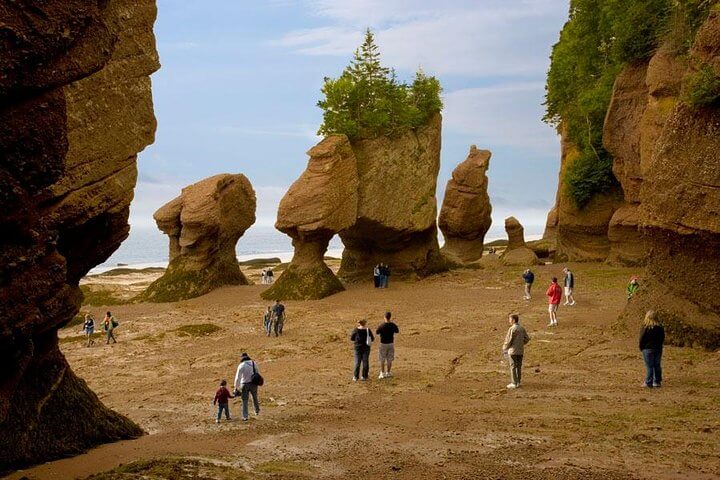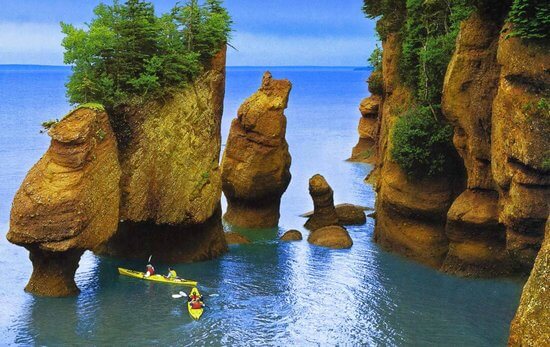No matter where you are in Canada, the scenery is breathtaking. The rock formations formed thousands, if not millions, of years ago are some of the most intriguing sites in Canada. Here are the locations of eight of Canada’s most amazing rock formations.
Balancing Rock – Nova Scotia – Canada Rock

You’ll understand why Balancing Rock received its moniker with only one look. This vertical column, made of volcanic basalt, has managed to stand tall while columns around it have crashed into the sea. Considering its perilous position, Balancing Rock is surprisingly stable. According to local folklore, cheeky fisherman once tried to pull Balancing Rock off its perch with their boats, but it defied gravity just as strongly as it does now. Balancing Rock is located near the town of Tiverton, Nova Scotia, and is a popular stop on the way to Brier Island. Take the ferry from Digby Neck to Long Island and follow the signs to Balancing Rock.
Rocher Percé – Quebec

Rocher Percé, or ‘Pierced Rock,’ is a limestone monolith rising from the sea that serves as both a landmark and an inspiration for mythology. The formation gets its name from a 15-meter-high arch that looks like a needle penetrating the granite. One of Rocher Percé’s stories is about a young Frenchman transported to Canada and his fiancee who can’t take being separated from him. She traveled to the new world with her true love, but pirates attacked as the ship approached its destination.
When the pirate captain saw her, he fell in love and insisted on marrying her. Because the brave girl had no intention of marrying anybody other than her fiancé, she devised a scheme and agreed to marry the pirate captain. She bravely hurled herself into the sea when the pirate’s ship approached the shore where her true love was stationed. The pirate ship was destroyed on Rocher Percé due to a weird fog. Rocher Percé is located off the shore of Gaspé, Quebec, and can be seen from the coast or up close on a boat excursion. Combine a visit to Rocher Percé with a journey to adjacent Bonaventure Island to see one of the world’s largest gannet colonies.
Hopewell Rocks – New Brunswick – Canada Rock

Hopewell Rocks in New Brunswick is all about the tide. You can see little green islands rising above the ocean at Hopewell Rocks at high tide. But come during low tide (check the tide tables ahead of time) when the rocks are at their most magnificent, and it’s a completely different tale. When the water recedes, the islands are transformed into 40- to 70-meter-tall sandstone pillars. Visitors can walk around the beach surrounding these tall columns, also known as ‘flowerpot rocks’ due to the little trees and grass on their tops.
At low tide, walk along the sandy beach and look for formations, including Lover’s Arch, Dinosaur Rocks, and E.T. The Bay of Fundy is known for its strong and swift tides, so return to the stairway before the tide comes in. Learn about Hopewell Rocks at the on-site Visitor Centre before hiking the path to the look-off and beach stairway on the Hopewell Cape near Moncton, New Brunswick.
Flowerpot Rocks – Ontario

Flowerpot Rocks in Ontario formed very differently from Hopewell Rocks in New Brunswick. The towering columns, known as’sea stacks,’ are formed of dense fossilized coral on top and petrified sea floor on the bottom. The Flowerpot Rocks’ sea floor bottoms erode more slowly than their tops, giving them a top-heavy structure.
The Flowerpot Rocks have stood for hundreds of years, however, they are not indestructible. There are two sea stacks visible now, and there was a third, but it fell in 1903. The Flowerpot Rocks are located on Flowerpot Island, which is suitably named. Visit adjacent Bruce Peninsula National Park, which includes a boat ride to Flowerpot Island. Hike the trails on the island, and see the sea cave, a historic lighthouse, and the famed Flowerpot Rocks. Take a boat ferry from Tobermory, Ontario to get to Flowerpot Island.
The Dungeon – Newfoundland

Look down into the Dungeon with caution; it’s a long drop to the foamy waters below. This skull-like formation was once two sea caves, the entrances to which are visible at the formation’s base today. Strong Atlantic waves eroded the caves over time until the roof fell downwards, leaving the unique-shaped sinkhole known as the Dungeon.
The waters at the Dungeon’s bottom are dangerous, and visitors should use caution around the cliffs at its edge. It will truly become an impenetrable dungeon if you become trapped in the depths! The Dungeon is located on Newfoundland’s windswept Cape Bonavista. Remember to stroll over the far side to get a new perspective on this unusual Canadian granite formation.
Hoodoos – Alberta – Canada Rock

Hoodoos are an otherworldly sight found in the dry landscape of Alberta’s Badlands. These slender columns with enormous tops originated some 75 million years ago and appear to have come from another planet. Hoodoos, also known as ‘tent rocks,’ ‘fairy chimneys,’ and ‘earth pyramids,’ are one of Canada’s most bizarre rock formations.
Hoodoos in Alberta are formed of clay and sand, and its massive ‘capstone’ erodes more slowly than its column, giving them their distinctive appearance. Hoodoos can reach three meters and are constantly eroded by rain, wind, and ice. The best examples of hoodoos in Canada can be found in Drumheller, Alberta. A trail goes through the group of rock formations, allowing you to get up and personal with these delicate structures.
Chimney Rock – British Columbia
When hiking through Marble Canyon in British Columbia, look up to see the 45-meter-tall Chimney Rock towering above you. Chimney Rock, made of limestone (similar to the canyon), is not simply for visiting; daring rock climbers have scaled this enormous monolith.
The locals say gods transformed people or animals into big stones as warnings or inspiration. In the case of Chimney Boulder, Coyote converted the rock into a part of his male anatomy (which shall remain unnamed). Rock climbing is popular in Marble Canyon, so pick up a copy of the rock climbing book before you go.
Prince Edward Island’s Teapot Rock
Canada’s smallest province, known for its red sand, red clay, and red potatoes, also contains one of the coolest red rocks in the country. Teapot Rock, a teacup-shaped sea stack, is a short stroll down the coast. The rock surrounding the Teapot deteriorated faster than the Teapot itself, leaving the sandstone sea stack alone in the water, waiting for someone else to join the tea party.
Teapot Rock can be seen on Prince Edward Island’s north shore near Darnley. A trek along the beach from the nearby Twin Shores campground leads to a view of the rock from the coast. For more daring visitors, take a kayak out into Thunder Cove’s waters to get a closer look at the sea stack.
